 Technology peripherals
Technology peripherals
 AI
AI
 Stanford 2023 AI Index Report is out! China dominates the top AI conferences, with the Chinese Academy of Sciences ranking first in the world in terms of published papers
Stanford 2023 AI Index Report is out! China dominates the top AI conferences, with the Chinese Academy of Sciences ranking first in the world in terms of published papers
Stanford 2023 AI Index Report is out! China dominates the top AI conferences, with the Chinese Academy of Sciences ranking first in the world in terms of published papers
Today, Stanford released the 2023 AI Index Report.
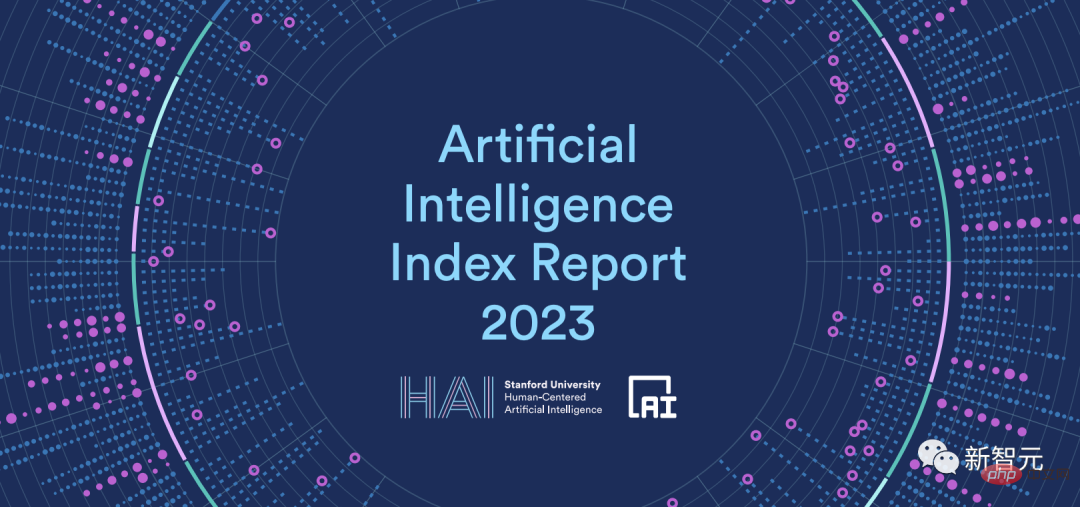
It is worth noting that the Stanford AI Index report lists the top ten institutions in the world in terms of "AI paper publication volume", and 9 of them are all from China. , have caught up with MIT.
They are: Chinese Academy of Sciences, Tsinghua University, University of Chinese Academy of Sciences, Shanghai Jiao Tong University, Zhejiang University, Harbin Institute of Technology, Beihang University, University of Electronic Science and Technology of China, Peking University, and MIT.
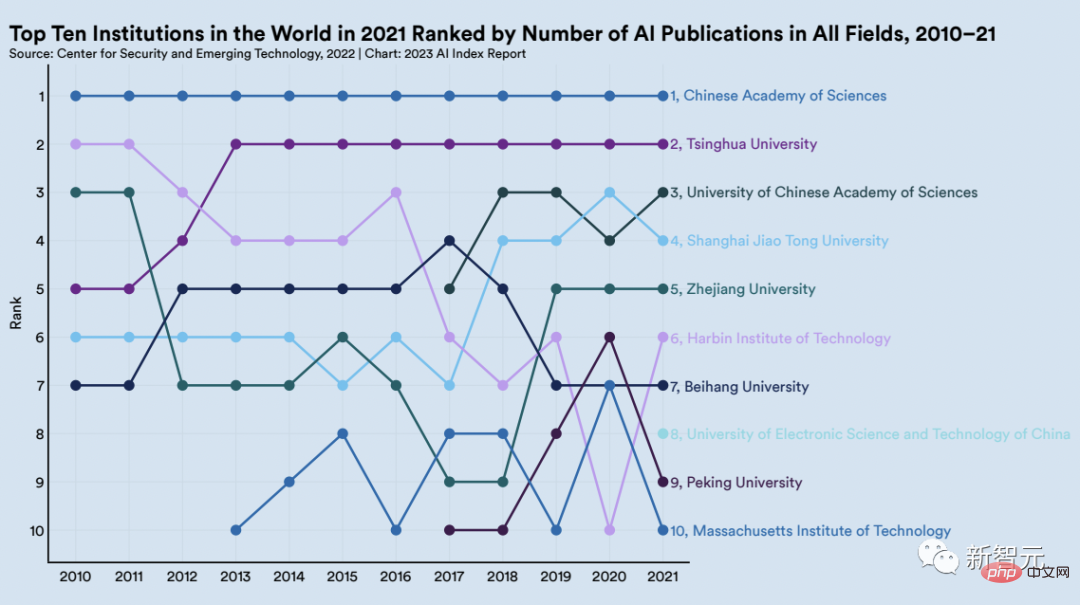
This year’s report is mainly divided into eight major sections: research and development, technology performance, artificial intelligence technology ethics, economy, education, policy and governance, diversity, and public opinion.
The following content extracts several key points of the report.
The two countries rank first in paper cooperation in the world
From 2010 to 2021, although the pace of cross-border cooperation in AI papers has slowed down, since 2010, the United States The number of artificial intelligence research cooperation with China has increased by approximately 4 times, which is 2.5 times greater than the total number of cooperation between China and the UK.
However, from 2020 to 2021, the total number of cooperation between the two countries only increased by 2.1%, which was the smallest year-on-year growth rate since 2010.
Additionally, the total number of AI papers has more than doubled since 2010. It has increased from 200,000 articles in 2010 to nearly 500,000 articles in 2021 (49,601).
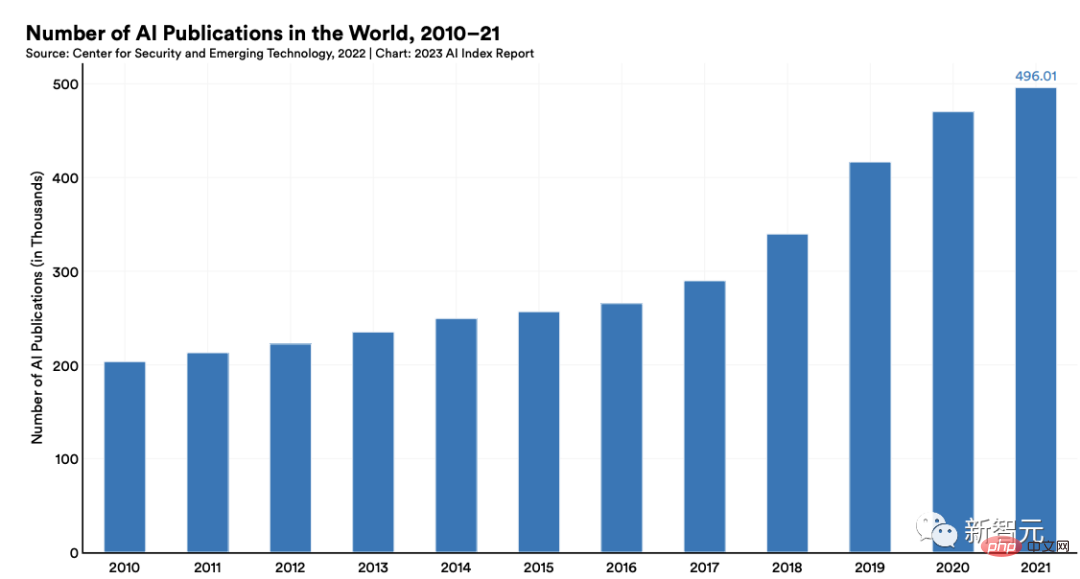
In terms of the types of AI papers published, in 2021, 60% of all published AI papers are journal articles, and 17% are Conference papers, 13% come from repositories.
While journal and repository papers have grown 3-fold and 26.6-fold, respectively, over the past 12 years, the number of conference papers has declined since 2019.
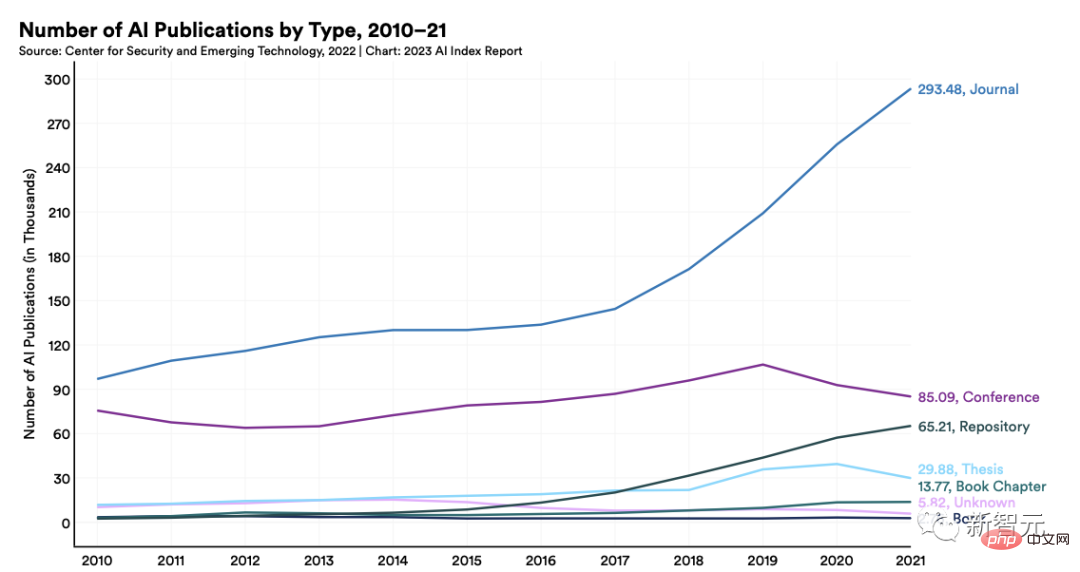
Pattern recognition, machine learning and computer vision are still hot topics in the field of artificial intelligence.
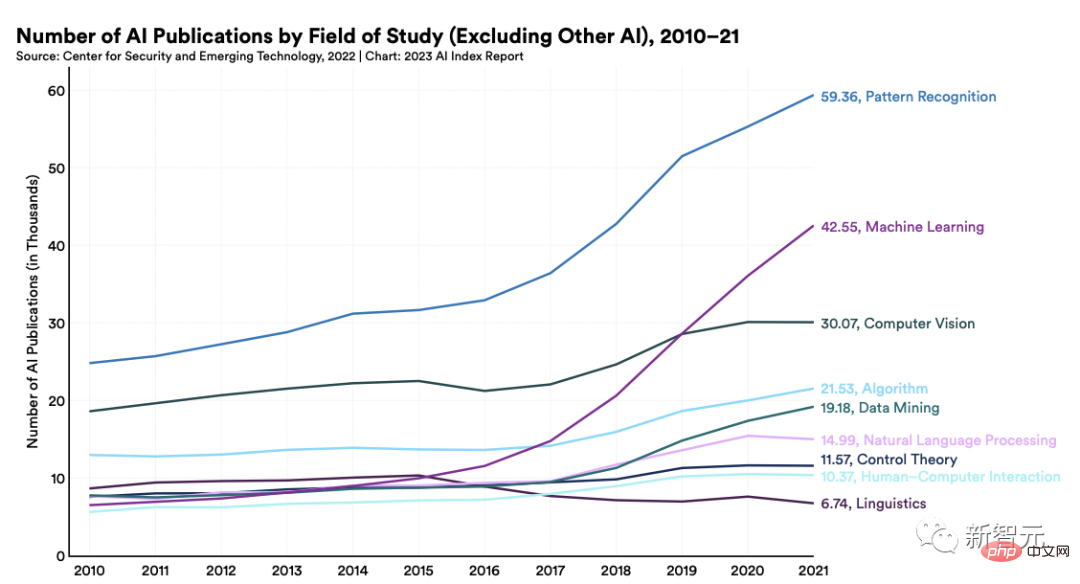
China still leads the way in terms of the total number of papers in journals, conferences and repositories.
The United States still leads in AI conference and repository citations, but these leads are slowly eroding. Despite this, the majority of the world's large language models and multimodal models (54% in 2022) are produced by US institutions.
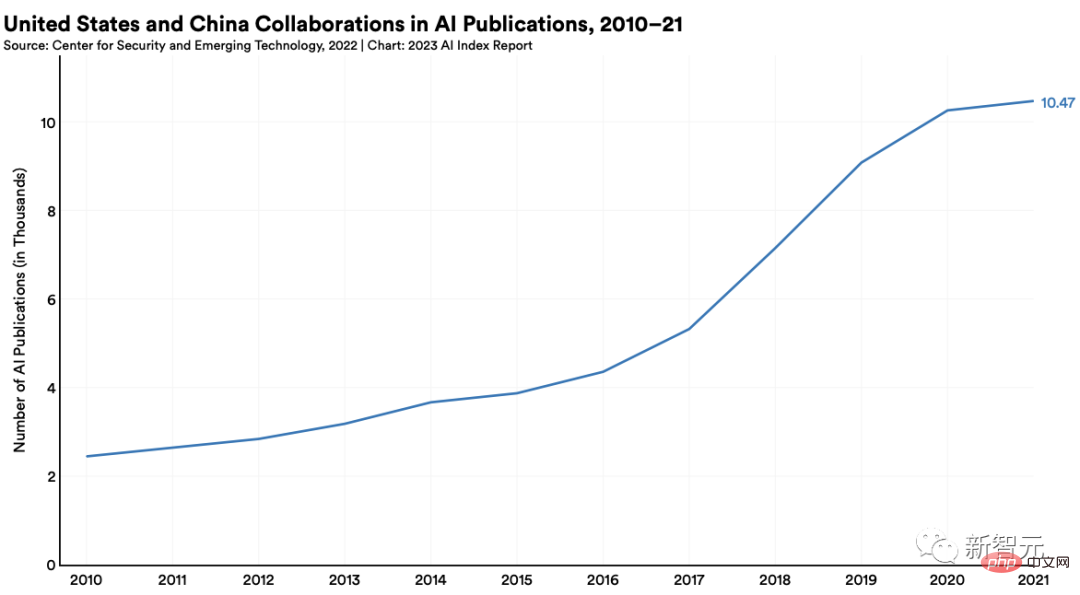
China dominates the top AI rankings, but the number of citations is lower than that of the United States
China has always maintained its lead in publishing AI journal papers status, 39.8% in 2021, followed by the European Union and the United Kingdom (15.1%), and then the United States (10.0%).
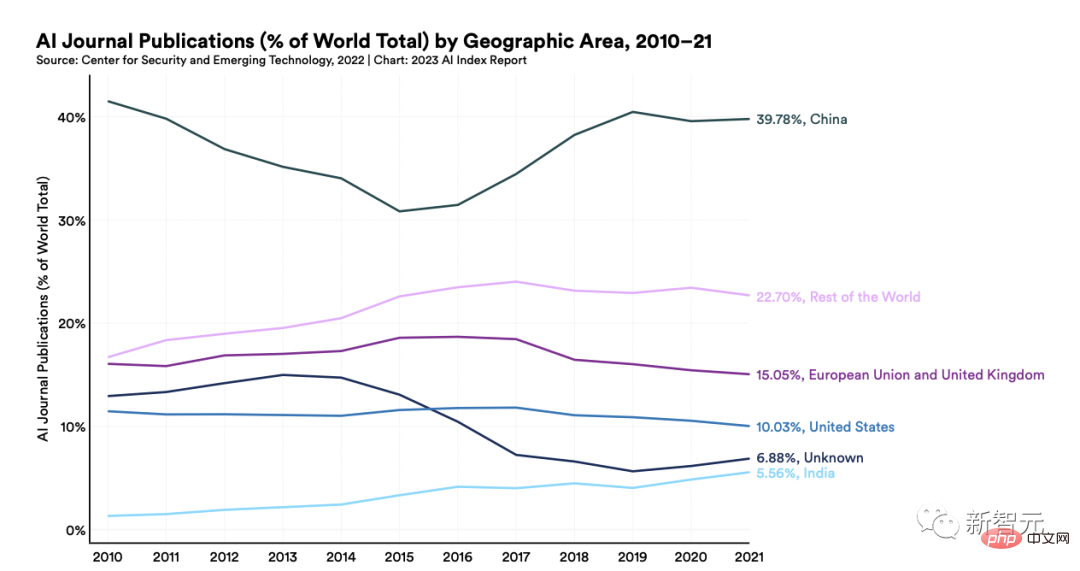
Since 2010, the proportion of citations of Chinese artificial intelligence journal papers has gradually increased, while the EU, UK, and United States have all declined. China, the European Union, the United Kingdom, and the United States account for 65.7% of the total global citations.

So, what is the situation of papers published at the world’s top conferences?
In 2021, China has the largest share of papers published at the top global AI conferences with 26.15%, followed by the European Union and the United Kingdom with 20.29%, and the United States with 17.23 % ranked third.
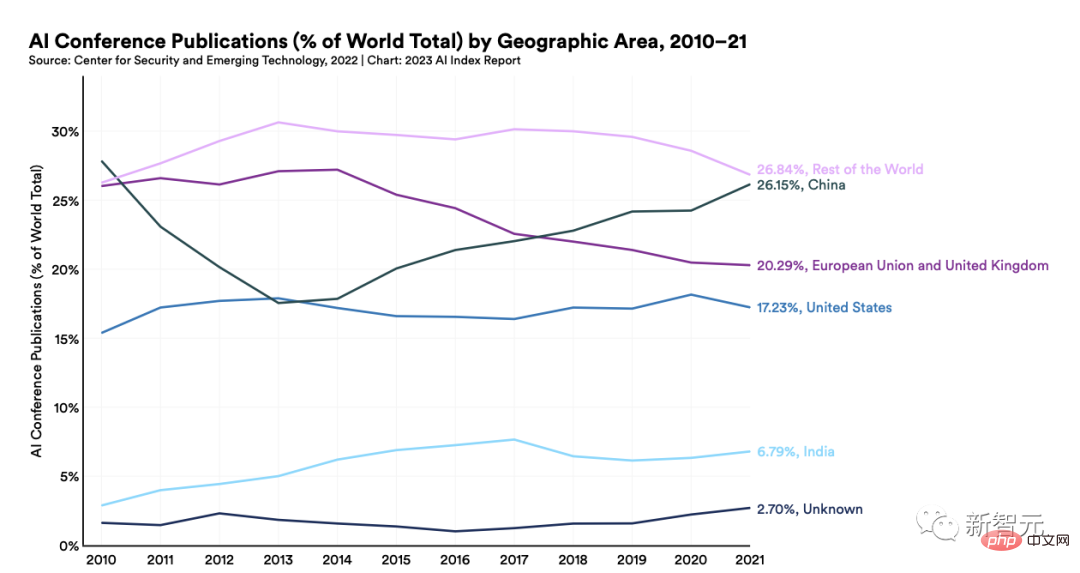
Judging from the number of citations of top conference papers, although China is highly productive, its number of citations is lower compared to the United States. The number of citations of top conference papers in the United States was 23.9%, and that in China was 22.02%.
It can be seen from the side that China publishes the largest number of papers, but the quality is not as high as that of the United States.
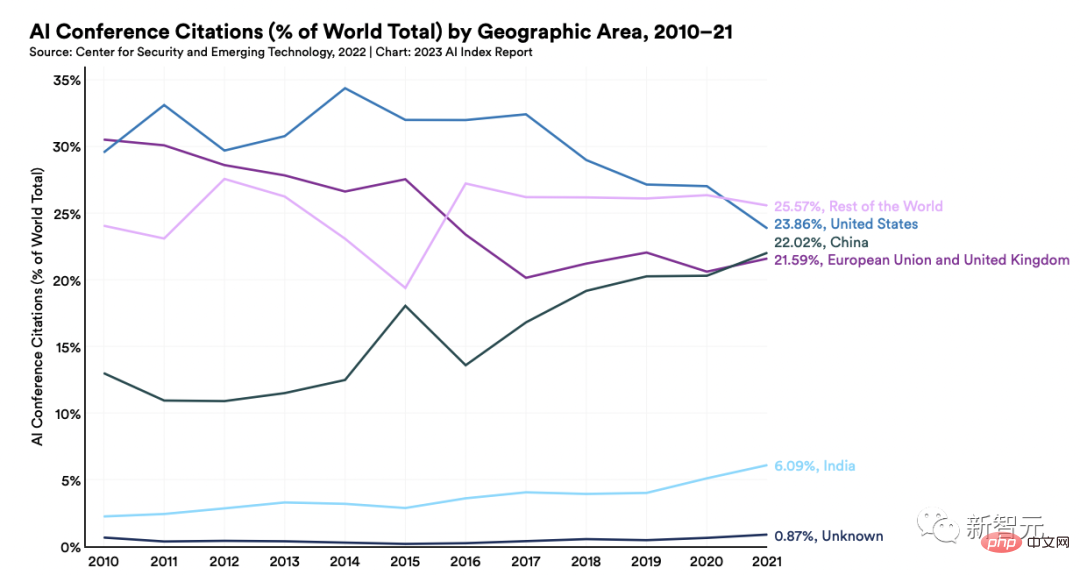
The United States leads the world in submissions to AI paper repositories, with 23.48%. China is the lowest, 11.87%.
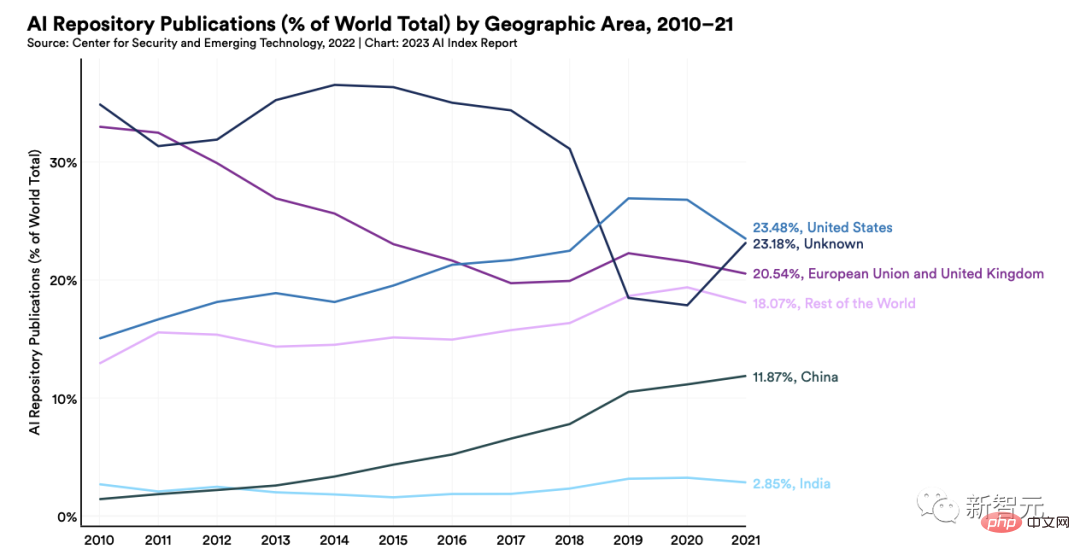
9 institutions in China, AI paper publishing catches up with MIT
In 2021, the total number of published papers is among the top ten institutions in the world , China accounts for 9. The total number of papers published by different institutions is as shown below. MIT ranks tenth, publishing 1745 papers.
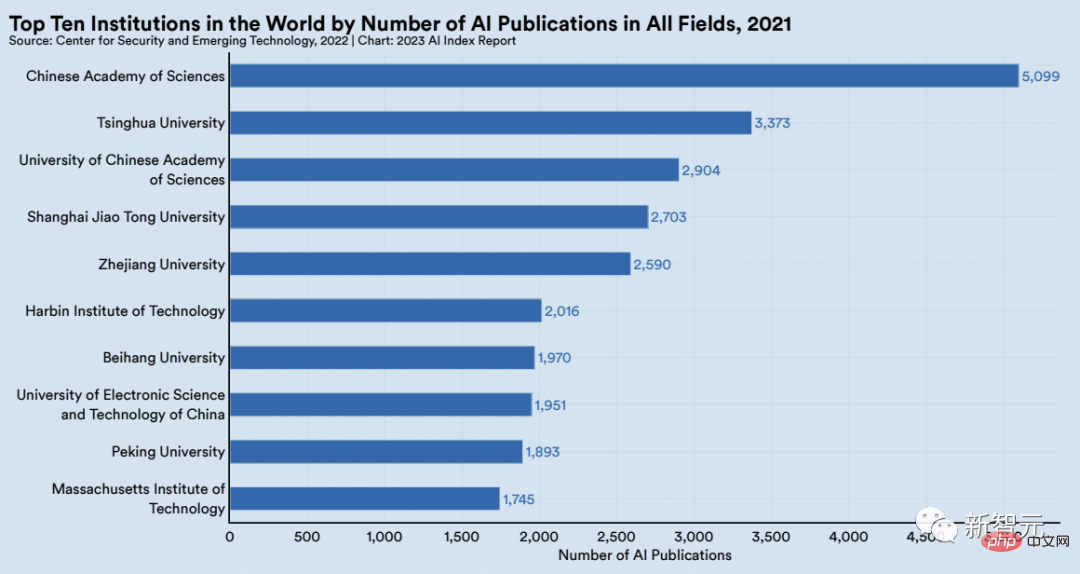
In terms of the field of computer vision (CV), China’s ten institutions rank among the top ten in the world. They are: Chinese Academy of Sciences, Shanghai Jiaotong University, University of Chinese Academy of Sciences, Tsinghua University, Zhejiang University, Beihang University, Wuhan University, Beijing Institute of Technology, Harbin Institute of Technology, and Tianjin University.

In the field of natural language processing (NLP), it is different.
The top ten institutions/companies in the world are: Chinese Academy of Sciences, Carnegie Mellon University, Microsoft, Tsinghua University, Carnegie Mellon University-Australia, Google, Peking University , University of Chinese Academy of Sciences, Alibaba, Amazon.
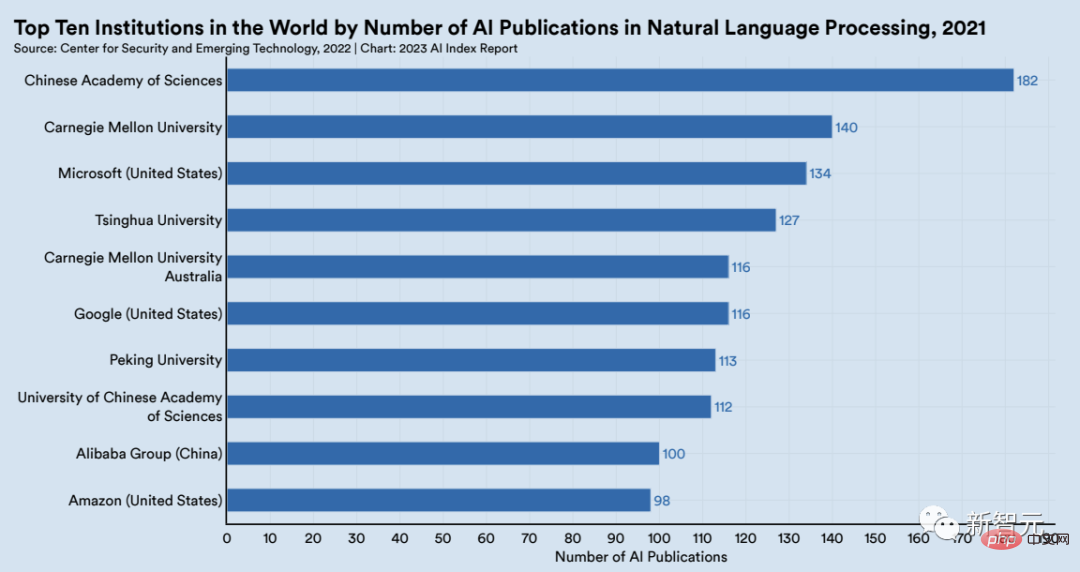
The rankings in the field of speech recognition are as follows:
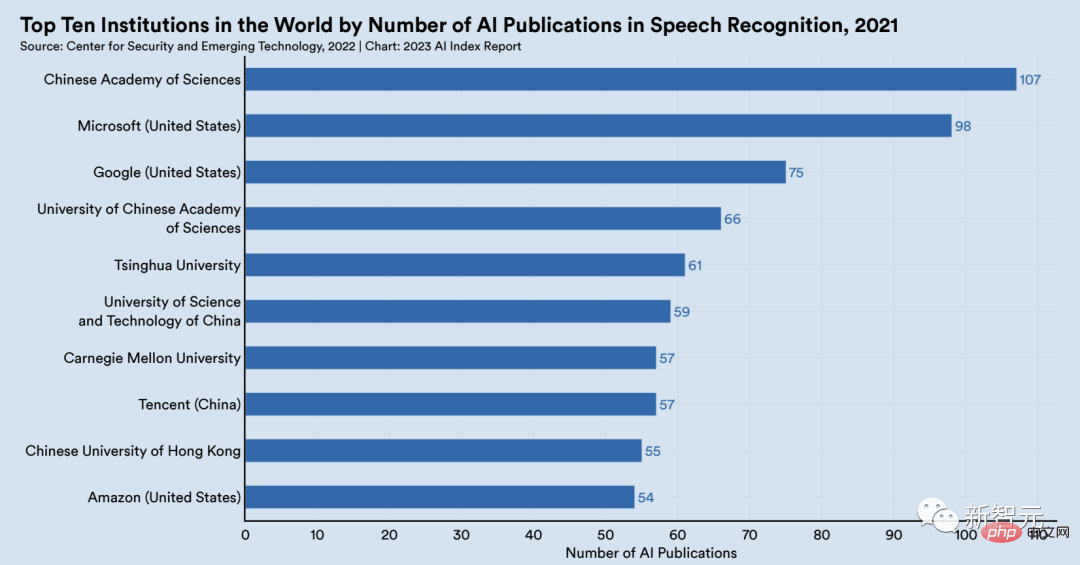
Industry leads academia
Among the important artificial intelligence machine learning systems released in 2022, language systems account for the most, with 23, which is 6 times the number of multi-modal systems.
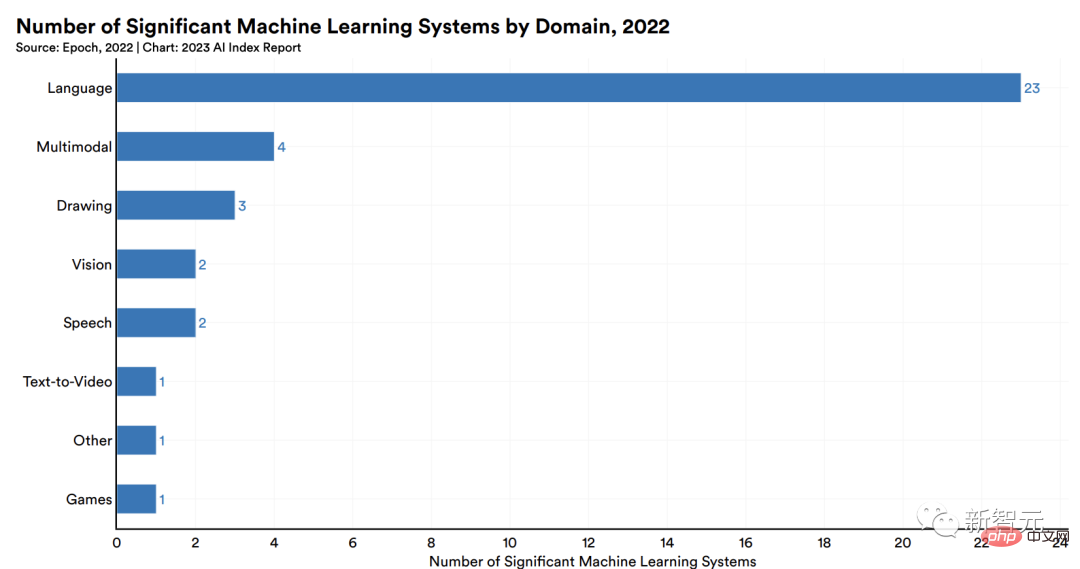
In terms of paper output, industry is ahead of academia.
Until 2014, most important models were published by academia. Since then, industry has turned around. By 2022, 32 important machine learning models will be born in industry, while only 3 will be in academia.

It can be seen that compared with non-profit organizations and academia, building state-of-the-art artificial intelligence systems increasingly requires large amounts of data, Computer capabilities and financial resources, and industry participants certainly have more financial resources to do this.
In 2022, the United States produced the largest number of important machine learning systems, with 16, followed by the United Kingdom (8) and China (3).
Furthermore, the United States has surpassed the United Kingdom and the European Union and China in terms of the total number of significant machine learning systems created since 2002
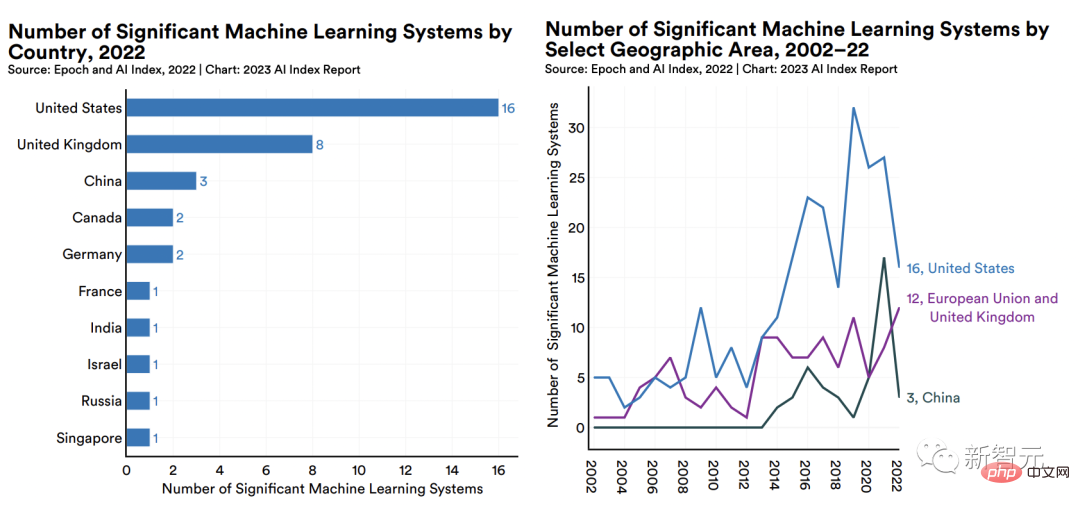
Looking at the distribution of researchers behind these important AI systems by country, the United States has the largest number of researchers, 285, which is more than twice that of the United Kingdom and nearly six times that of China.
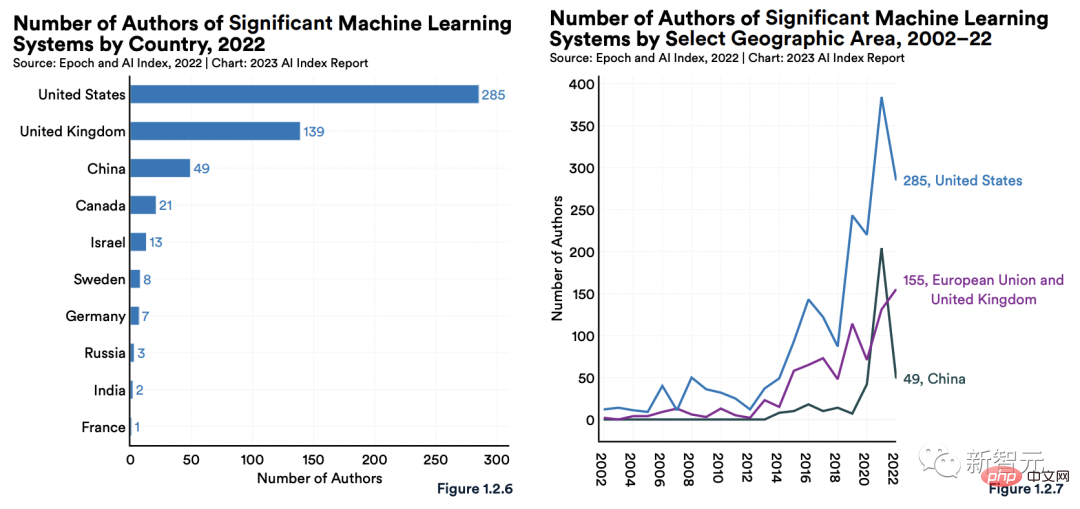
LLMs are getting bigger and bigger, and the computing power is more expensive
Large language and multi-modal models, sometimes called base models , is currently an emerging and increasingly popular type of AI model that is trained on large amounts of data and suitable for various downstream applications.
Large-scale languages and multi-modal models such as ChatGPT, DALL-E 2, and MakeA-Video have demonstrated impressive capabilities and are starting to be widely deployed in the real world.
The country affiliations of the authors of these models were analyzed and the majority of these researchers were from US institutions (54.2%).
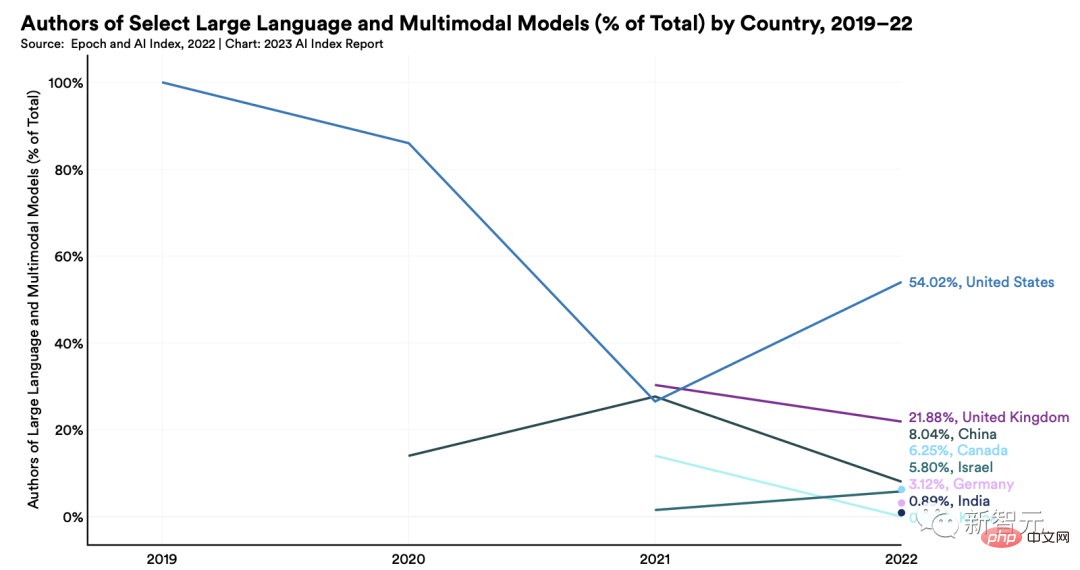
The Stanford AI Index report also lays out a timeline for the release of large language and multi-modal models.
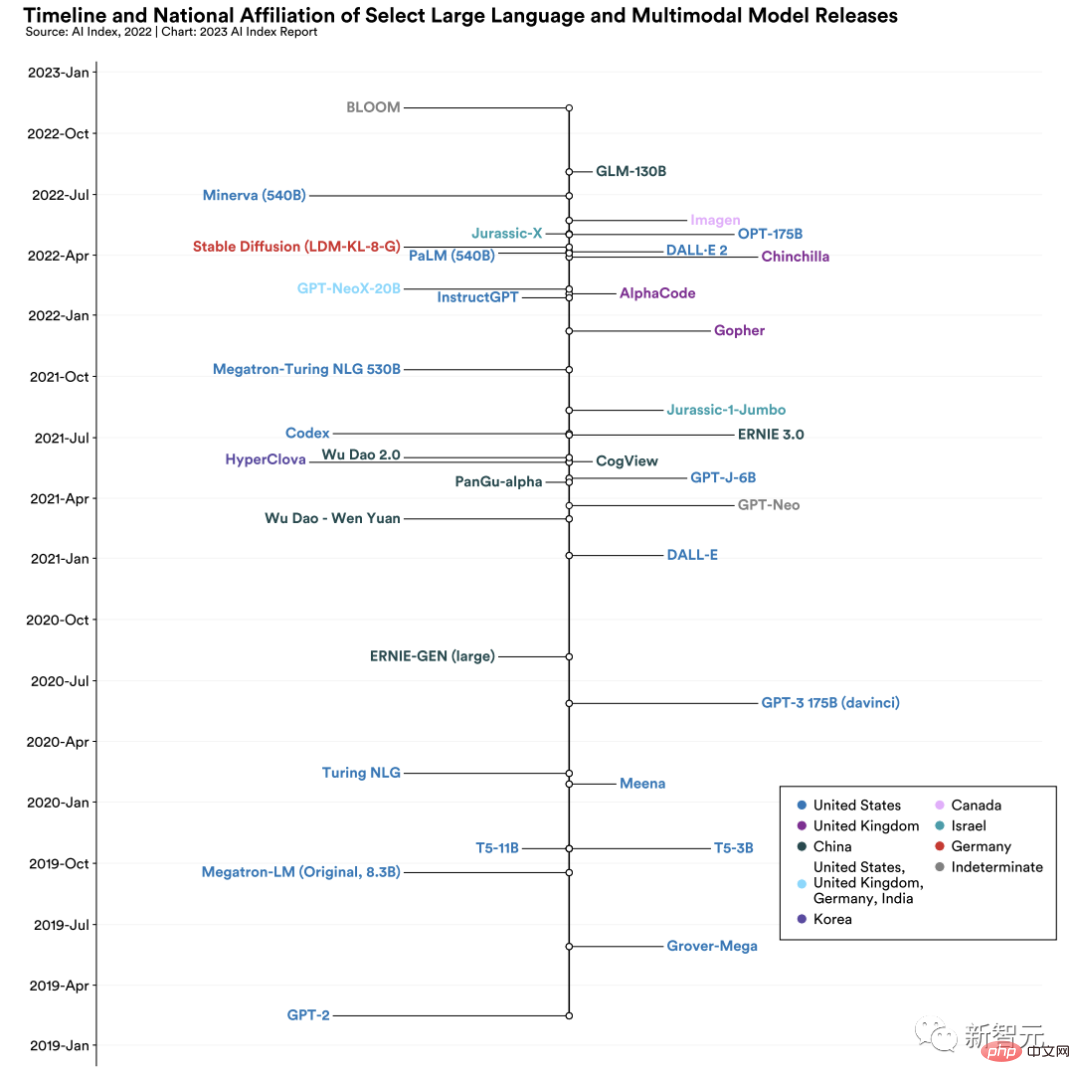
#Large language models are getting bigger and more expensive.
The first large-scale language model, GPT-2, was released in 2019, with 1.5 billion parameters and a training cost of about US$50,000. Google PaLM is one of the large language models launched in 2022, with 540 billion parameters and a cost of up to $8 million.
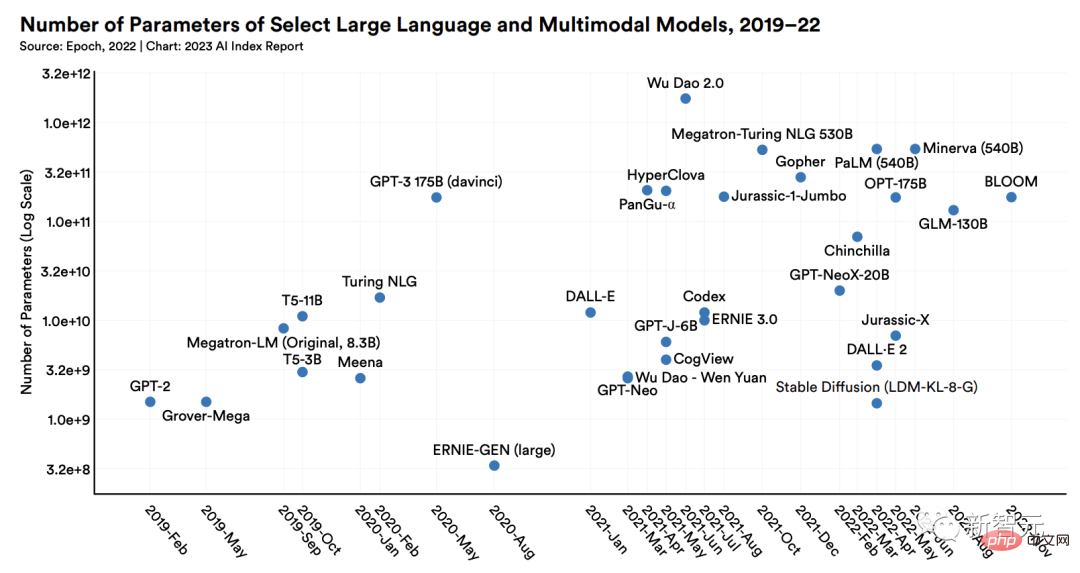
In terms of parameters and training costs, Palm is 360 times larger and 160 times more expensive than GPT-2.
It’s not just PalM, but large language and multimodal models as a whole are getting bigger and more expensive.
For example, Chinchilla, a large-scale language model launched by DeepMind in May 2022, is estimated to cost US$2.1 million, while training of BLOOM costs approximately US$2.3 million.
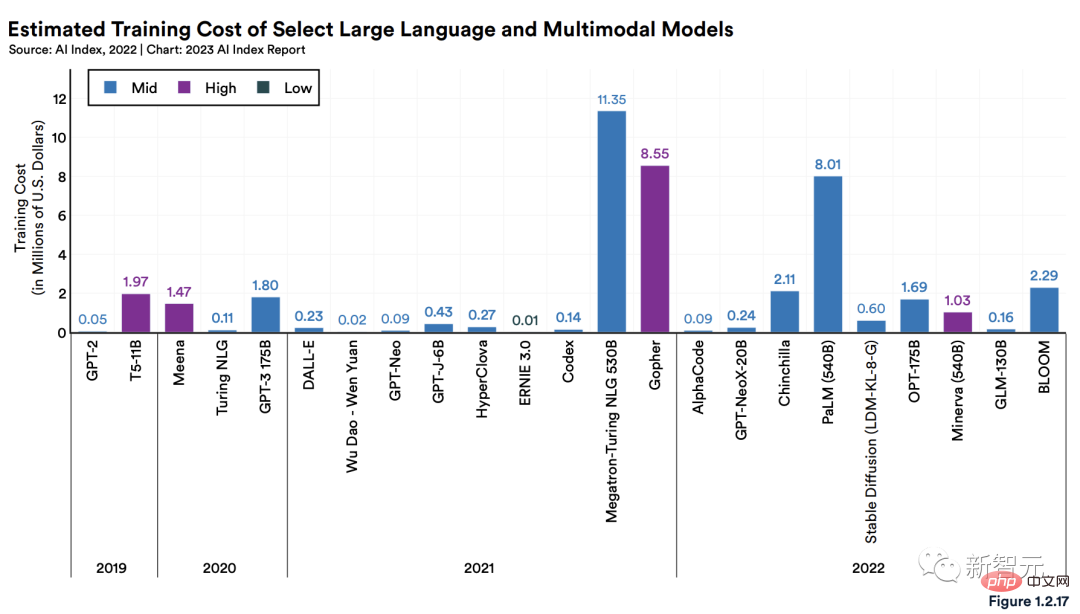
Over time, the progress of GAN in face generation, the last image was generated by Diffusion-GAN, this model in STL The latest SOTA was obtained on -10.

Last year, with OpenAI’s DALL-E 2, Stability AI’s Stable Diffusion, Midjourney, Meta’s Make-AScene, and Google’s Imagen With the release of the model, the text-to-image generation model has gradually entered the public eye.
As follows, enter the same prompt, "A panda plays the piano on a warm Parisian night", respectively, from three publicly accessible programs: DALL-E 2, Stable Diffusion and Midjourney. Image generated by AI text-to-image system.
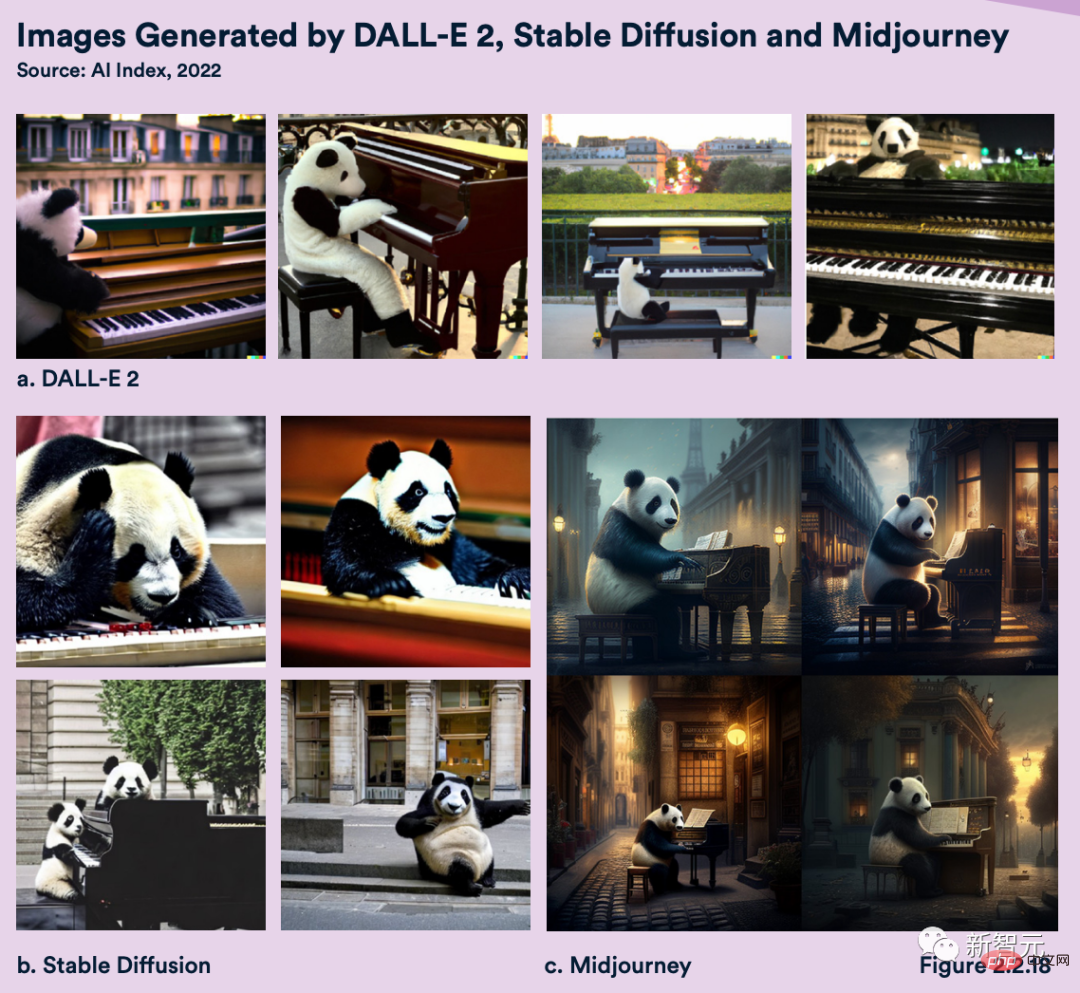
Among all recently released text-to-image generation models, Google’s Imagen performs best on the COCO benchmark.
This year, the Google researchers who created Imagen also released DrawBench, a more difficult text-to-image benchmark designed to challenge increasingly powerful text-to-image models.
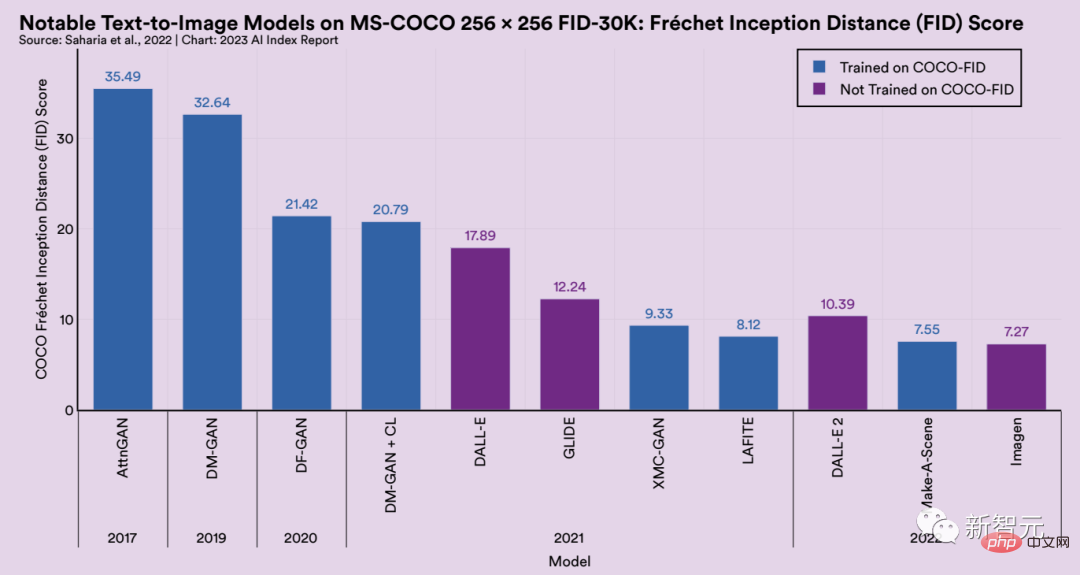
In addition, the report also introduced that there are some biases in the current generative AI model. For example, when prompting the CEO to DELLE-2, everyone seemed to take crossed arms in a confident pose.

In Midjourney, when prompted to generate "influencers" it generates 4 images of older looking white men .

For the complete report content, please see:
https ://aiindex.stanford.edu/wp-content/uploads/2023/04/HAI_AI-Index_Report_2023.pdf
The above is the detailed content of Stanford 2023 AI Index Report is out! China dominates the top AI conferences, with the Chinese Academy of Sciences ranking first in the world in terms of published papers. For more information, please follow other related articles on the PHP Chinese website!

Hot AI Tools

Undresser.AI Undress
AI-powered app for creating realistic nude photos

AI Clothes Remover
Online AI tool for removing clothes from photos.

Undress AI Tool
Undress images for free

Clothoff.io
AI clothes remover

Video Face Swap
Swap faces in any video effortlessly with our completely free AI face swap tool!

Hot Article

Hot Tools

Notepad++7.3.1
Easy-to-use and free code editor

SublimeText3 Chinese version
Chinese version, very easy to use

Zend Studio 13.0.1
Powerful PHP integrated development environment

Dreamweaver CS6
Visual web development tools

SublimeText3 Mac version
God-level code editing software (SublimeText3)

Hot Topics
 Bytedance Cutting launches SVIP super membership: 499 yuan for continuous annual subscription, providing a variety of AI functions
Jun 28, 2024 am 03:51 AM
Bytedance Cutting launches SVIP super membership: 499 yuan for continuous annual subscription, providing a variety of AI functions
Jun 28, 2024 am 03:51 AM
This site reported on June 27 that Jianying is a video editing software developed by FaceMeng Technology, a subsidiary of ByteDance. It relies on the Douyin platform and basically produces short video content for users of the platform. It is compatible with iOS, Android, and Windows. , MacOS and other operating systems. Jianying officially announced the upgrade of its membership system and launched a new SVIP, which includes a variety of AI black technologies, such as intelligent translation, intelligent highlighting, intelligent packaging, digital human synthesis, etc. In terms of price, the monthly fee for clipping SVIP is 79 yuan, the annual fee is 599 yuan (note on this site: equivalent to 49.9 yuan per month), the continuous monthly subscription is 59 yuan per month, and the continuous annual subscription is 499 yuan per year (equivalent to 41.6 yuan per month) . In addition, the cut official also stated that in order to improve the user experience, those who have subscribed to the original VIP
 Context-augmented AI coding assistant using Rag and Sem-Rag
Jun 10, 2024 am 11:08 AM
Context-augmented AI coding assistant using Rag and Sem-Rag
Jun 10, 2024 am 11:08 AM
Improve developer productivity, efficiency, and accuracy by incorporating retrieval-enhanced generation and semantic memory into AI coding assistants. Translated from EnhancingAICodingAssistantswithContextUsingRAGandSEM-RAG, author JanakiramMSV. While basic AI programming assistants are naturally helpful, they often fail to provide the most relevant and correct code suggestions because they rely on a general understanding of the software language and the most common patterns of writing software. The code generated by these coding assistants is suitable for solving the problems they are responsible for solving, but often does not conform to the coding standards, conventions and styles of the individual teams. This often results in suggestions that need to be modified or refined in order for the code to be accepted into the application
 Seven Cool GenAI & LLM Technical Interview Questions
Jun 07, 2024 am 10:06 AM
Seven Cool GenAI & LLM Technical Interview Questions
Jun 07, 2024 am 10:06 AM
To learn more about AIGC, please visit: 51CTOAI.x Community https://www.51cto.com/aigc/Translator|Jingyan Reviewer|Chonglou is different from the traditional question bank that can be seen everywhere on the Internet. These questions It requires thinking outside the box. Large Language Models (LLMs) are increasingly important in the fields of data science, generative artificial intelligence (GenAI), and artificial intelligence. These complex algorithms enhance human skills and drive efficiency and innovation in many industries, becoming the key for companies to remain competitive. LLM has a wide range of applications. It can be used in fields such as natural language processing, text generation, speech recognition and recommendation systems. By learning from large amounts of data, LLM is able to generate text
 Can fine-tuning really allow LLM to learn new things: introducing new knowledge may make the model produce more hallucinations
Jun 11, 2024 pm 03:57 PM
Can fine-tuning really allow LLM to learn new things: introducing new knowledge may make the model produce more hallucinations
Jun 11, 2024 pm 03:57 PM
Large Language Models (LLMs) are trained on huge text databases, where they acquire large amounts of real-world knowledge. This knowledge is embedded into their parameters and can then be used when needed. The knowledge of these models is "reified" at the end of training. At the end of pre-training, the model actually stops learning. Align or fine-tune the model to learn how to leverage this knowledge and respond more naturally to user questions. But sometimes model knowledge is not enough, and although the model can access external content through RAG, it is considered beneficial to adapt the model to new domains through fine-tuning. This fine-tuning is performed using input from human annotators or other LLM creations, where the model encounters additional real-world knowledge and integrates it
 Five schools of machine learning you don't know about
Jun 05, 2024 pm 08:51 PM
Five schools of machine learning you don't know about
Jun 05, 2024 pm 08:51 PM
Machine learning is an important branch of artificial intelligence that gives computers the ability to learn from data and improve their capabilities without being explicitly programmed. Machine learning has a wide range of applications in various fields, from image recognition and natural language processing to recommendation systems and fraud detection, and it is changing the way we live. There are many different methods and theories in the field of machine learning, among which the five most influential methods are called the "Five Schools of Machine Learning". The five major schools are the symbolic school, the connectionist school, the evolutionary school, the Bayesian school and the analogy school. 1. Symbolism, also known as symbolism, emphasizes the use of symbols for logical reasoning and expression of knowledge. This school of thought believes that learning is a process of reverse deduction, through existing
 To provide a new scientific and complex question answering benchmark and evaluation system for large models, UNSW, Argonne, University of Chicago and other institutions jointly launched the SciQAG framework
Jul 25, 2024 am 06:42 AM
To provide a new scientific and complex question answering benchmark and evaluation system for large models, UNSW, Argonne, University of Chicago and other institutions jointly launched the SciQAG framework
Jul 25, 2024 am 06:42 AM
Editor |ScienceAI Question Answering (QA) data set plays a vital role in promoting natural language processing (NLP) research. High-quality QA data sets can not only be used to fine-tune models, but also effectively evaluate the capabilities of large language models (LLM), especially the ability to understand and reason about scientific knowledge. Although there are currently many scientific QA data sets covering medicine, chemistry, biology and other fields, these data sets still have some shortcomings. First, the data form is relatively simple, most of which are multiple-choice questions. They are easy to evaluate, but limit the model's answer selection range and cannot fully test the model's ability to answer scientific questions. In contrast, open-ended Q&A
 SOTA performance, Xiamen multi-modal protein-ligand affinity prediction AI method, combines molecular surface information for the first time
Jul 17, 2024 pm 06:37 PM
SOTA performance, Xiamen multi-modal protein-ligand affinity prediction AI method, combines molecular surface information for the first time
Jul 17, 2024 pm 06:37 PM
Editor | KX In the field of drug research and development, accurately and effectively predicting the binding affinity of proteins and ligands is crucial for drug screening and optimization. However, current studies do not take into account the important role of molecular surface information in protein-ligand interactions. Based on this, researchers from Xiamen University proposed a novel multi-modal feature extraction (MFE) framework, which for the first time combines information on protein surface, 3D structure and sequence, and uses a cross-attention mechanism to compare different modalities. feature alignment. Experimental results demonstrate that this method achieves state-of-the-art performance in predicting protein-ligand binding affinities. Furthermore, ablation studies demonstrate the effectiveness and necessity of protein surface information and multimodal feature alignment within this framework. Related research begins with "S
 SK Hynix will display new AI-related products on August 6: 12-layer HBM3E, 321-high NAND, etc.
Aug 01, 2024 pm 09:40 PM
SK Hynix will display new AI-related products on August 6: 12-layer HBM3E, 321-high NAND, etc.
Aug 01, 2024 pm 09:40 PM
According to news from this site on August 1, SK Hynix released a blog post today (August 1), announcing that it will attend the Global Semiconductor Memory Summit FMS2024 to be held in Santa Clara, California, USA from August 6 to 8, showcasing many new technologies. generation product. Introduction to the Future Memory and Storage Summit (FutureMemoryandStorage), formerly the Flash Memory Summit (FlashMemorySummit) mainly for NAND suppliers, in the context of increasing attention to artificial intelligence technology, this year was renamed the Future Memory and Storage Summit (FutureMemoryandStorage) to invite DRAM and storage vendors and many more players. New product SK hynix launched last year





